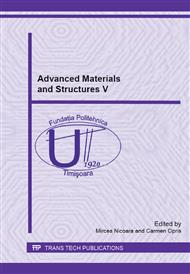p.205
p.210
p.216
p.222
p.226
p.233
p.239
p.243
p.249
Wear Particle Analysis, the Result of Tribological Phenomena of Biomaterials Couplings-Ultra Hight Molecular Weight Polyethylene and Magnesium Aluminosilicate Ceramic
Abstract:
Joint prosthesis involves the combination in the form of friction couplings of the different materials such as two metals, metal-polymer and polymer-ceramic. This paper aims to analyze the wear particles produced from the friction between two biomaterials: ultra hight molecular weight polyethylene ( uhmwpe ) and magnesium aluminosilicate ceramic. To obtain the wear particles using a tribometer cetr umt-2 type that can reproduce the wear phenomena of different biomaterials in different humidity conditions and at various speeds of movement. The tests were performed in dry and lubricated friction conditions using saline solution, the best imitating biological conditions. The movement is similar to the friction torques of the hip joint: a semicircular motion of the polymer piece on the circular surface of the ceramic piece. Movement speed chosen is 0.25 m/s. Wear particles obtained were isolated from biomaterial surfaces and studied using scanning electron microscope. The images obtained are analyzed, particle's dimensions are extracted and then imported into autocad can provide information about the shape, size and surface of the particles. In light of these facts, we can say the inflammatory risk of biomaterial particles. In conclusion, the biomaterial particles are very small and the inflammatory rick is reducing to minimum in lubricated conditions.
Info:
Periodical:
Pages:
226-230
Citation:
Online since:
August 2014
Authors:
Keywords:
Price:
Сopyright:
© 2014 Trans Tech Publications Ltd. All Rights Reserved
Share:
Citation:


